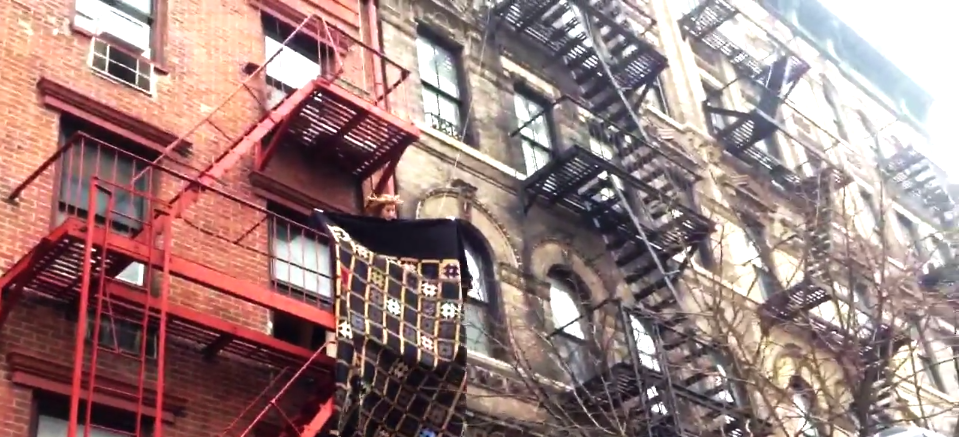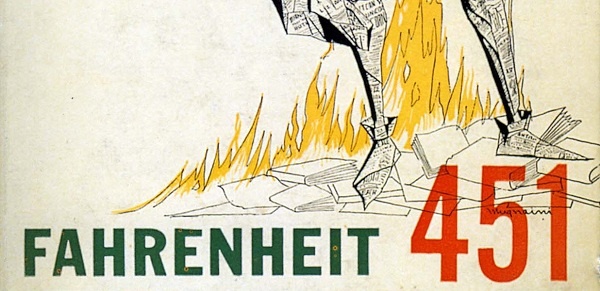


Today’s PaperGirl is a link!
A link to a video. A video I cannot figure out how to just play within this entry. It’s extremely embarrassing and I forgot to ask Yuri before he went to bed. The upside is that in the screen shot I took from the video, my hair is flying around like magic. Look at that!
Enjoy this video. Relatively speaking, it did not take long to make. But I do blame my tardy posts lately on it and the other 5,000 things that are happening right now. It will pass, I promise. I did make a pledge and I don’t take these things lightly.
Here is the video for my book. There may be others.
Love,
Pendennis (??)

Something magical has happened.
As excited as I was about getting my BabyLock here in New York, cold, hard reality smacked me upside the head the moment I took that glorious sewing machine out of the box: there’s about as much room for quilt-making in this apartment as there is for woodworking or ballroom dancing, which is to say there is none. What to do? To make patchwork is to live — and I am not ready to die.
Well, it just so happens that I have lovely friends. And those friends have lovely friends. And the majority of this collection of people, we make things with our hands. There exists a kind of code, or a kinship with us: no one is going to let anyone die from art/craft-related complications. You need a 1/2 yard of a Kaffe Fassett print from 2006? Baby, I’ma hook you up. Fresh out of sequins? I got this! We trade binding for quilting, piecing for yarn; we share scissors, gum, patterns, rides to the airport to go to the shows. We help each other because we’re human and humans (mostly) help each other, but we go extra miles for makers because we are also makers.
And so it was that on Friday, a kind and virtuous friend (let’s call her Susan because her name is Susan) was in New York and wanted me to meet someone. She wanted me to meet Tavy, co-owner of The Yarn Company on the Upper West Side. For all the quilters out there who are also knitters or yarnfolk, you may have just squealed with delight. The Yarn Company is a legendary yarn and knitter’s shop. It was the cradle of the knitting craze that began in the 1970s, the craze that has stayed with us ever since, waxing and waning over the decades a bit but mostly waxing. When celebrities in the 1970s were in homemaker magazines with their crochet hooks, they got them at The Yarn Company. When knitting got hot again with the so-called DIY’ers in the late 1990s, The Yarn Company was right there, packing its slender rooms on the second floor with crazed, “I must knit nine more scarves immediately!” people who flocked to yarn mecca.
Tavy and her brother Assaf bought the shop in 2011 and breathed new, needed life into the place. These days, it’s all warm wood and great light and big, broad tables. The yarn surrounds your very soul when you walk in: there are colors and textures of yarn that defy description, they’re so beautiful and soft. If yarn could melt in your mouth — if that were something that you would want to have happen — you’d get that yarn at The Yarn Company.
But it ain’t just skeins over there. The shop likes sewists and they love quilters, too. They have a gorgeous collection of yardage, though it’s modest at the moment. They teach sewing classes. When Tavy and her brother bought The Yarn Company, their vision from the start was to incorporate more makers than just the yarn people.
Enter The Yarn Company’s first-ever Quilter In Residence: me!
The good people of The Yarn Company have extended an invitation to me to set up my machine in the second room of the shop so that I can cut, sew, press, design, and hang out there. (I plan to learn to knit by osmosis.) I’ll be able to talk to knitters about quilts and why they should make them. I’ll be able to have a little design wall, something not possible in the apartment at all. I can answer patchwork questions if they come up while I’m there during business hours and I can sew late into the night! And there’s amazing vegan food across the street! Not that I’m vegan! But still! Vegans! Sewing blocks! Upper West Side! Yarn people! City quilting! Oh, the humanity!
This is gonna be really fun. My thanks to The Yarn Company in advance. Watch this space for news about events and things because they’re sure to occur. Tomorrow, I’ll go to the shop and set up my Elissimo and my cutting mat (thanks, Havel’s Sewing!) and I promise to post pictures on Facebook of what’s being made.
Just get out of bed in the morning. That’s all you have to do. Life transpires.

Every year for (oh my) nine years? ten? something ridiculous like that, I have served as a presenter at Fremd High School’s Writer’s Week. Writer’s Week XIX kicks off on Monday, and I just happen to be headed to Chicago on Tuesday, so on Wednesday morning, bright and early, I’m taking a Metra train to Palatine and to try and kick up a little writer-y magic for my Fremd homies.
Here’s an abbreviated description of what Writer’s Week is, taken from the Fremd website:
“Writers Week began in 1995 when we featured students, faculty, and professional writers during lunch hours for a week in April. Since then, about a thousand Fremd students have taken the stage to share their writing. Faculty members from every department have related their stories through writing. More than two hundred professional writers from around the world have visited the Fremd campus during Writers Week to help us better understand writing and authors.”
Good idea, right? Lots of folks agree, including the likes of Gwendolyn Brooks, who presented at Fremd years ago. Billy Collins. Marc Smith. These are writers of consequence, authors whose work has shaped (still shapes) the American literary conversation. And because people on that little patch of land in Illinois believe in the power of and the need for good writers writing, high school students get to walk into an auditorium in their very own high school and receive the lessons, the joy, the discomfiting feelings — the blessed thought — good writing can bring. The amount of work involved in putting on Writer’s Week is head-spinning. Scheduling, booking, fundraising, booster-ing, coordinating — it’s nothing any of the teachers get paid extra to do and they do it all anyway, year after dedicated year.
I’m slightly famous at Fremd because I usually end up kissing people. There’s a piece in my lil’ repertoire that involves kissing an audience member. You want to make an impression on an auditorium full of 500+ high school students? Try kissing one of them. I’m not making out with anyone; it’s just a kiss on the cheek. But it’s a kiss on the cheek with commitment, and I’m nothing if not committed. That usually causes a stir, but I might be famous at Fremd because I write a poem on the spot for a student every year, or because I had a breakdancer kick it onstage (he was up there anyway getting a poem!), or because I presented a Lady Gaga song as verse once time — anything can happen and I think we all like it that way. Whatever the material might be, I give 100% of myself (my attention, my focus, my passion for words, my passion for having fun with them for heaven’s sake) to the Fremdians.
I seriously love that entire high school. It’s like we’re dating long-distance. I don’t see you very often, darling, but when I do, when I do.
I’ll dress up for you, darling. And I’ll bring you a gift from New York. Wait for me.

There was a tiny shift in my brain a couple weeks ago that changed the way I see New York City. The shift will probably change the way I see a lot of things because it was so simple. The simplest concepts are the stickiest: work hard, take a jacket, crack is wack, etc. It’s slightly embarrassing to admit, but since it might help someone else, here goes:
You don’t have to learn the subway system in New York. You just need to figure out how to get where you need to go.
Let’s have that again:
You don’t have to learn the subway system in New York. You just need to figure out how to get where you need to go.
I’ve been coming to Manhattan with fair frequency since I was sixteen. Until three weeks ago, on every trip here, I operated under two subtle, negative assumptions: 1) to get around New York City properly (?) you need to know the subways and 2) figuring that out would mean seriously studying the system at length and doing the MTA equivalent of times tables or vocabulary drills. That was how I thought, and you can marvel at the weirdness of it, but I ask you to marvel with attendant compassion. I look at those assumptions and I think, “My goodness, who was in charge of this girl? Why on earth did she think she had to take graduate-level course work in the New York subway system? Poor thing, someone wrap her in a quilt and get her a piece of chocolate. No, the whole bar. The Ritter Sport. She likes the dark chocolate with hazelnu — yes, that’s it. Here you are, dear.”
(MARY eats chocolate, nods pathetically.)
All that business about being perpetually in the dark about the subway system ended the other day in a flash, don’t ask me why. You don’t have to know the trains. You don’t have to know where the A, C, E trains terminate. You don’t have to memorize the stops on the 6 from Fulton to 110th St. Not only do you not have to do that as a new New York person, you don’t ever have to do that. By osmosis and routine, you will naturally learn subway route details and shortcuts. But the vast majority of veteran New Yorkers don’t know when the 7 runs express to Queens and when it runs local and if you asked them about it, they’d say, “I don’t know, ask the ticket agent,” or “There’s a map over there, I don’t know, sorry.”
If you want to go somewhere, find your somewhere on the map, and then figure out which train will take you close to it. Thought I’ve done just that for years, I always came at it cock-eyed, as though the train system was my destination, not the Natural History Museum. There was this little, niggling voice that said, “You should know this by now,” and that voice distracted me from noticing what I was doing: getting around New York just fine.
Did any of that make a lick of sense?
It’s just a subway system, it’s just a map. It’s just a city, it’s just a person. But the shift in my head from “you’ll never get this” to “you already have this” has given me that singular feeling of “Oh, right. I’m not broken, I’m not wrong, I never was wrong, I was making it too hard, everything I need, I already have.”
Pretty good at $2.25/fare.

Plenty of folks tell you what’s good and what you should like:
“This restaurant is so good, you’ll love it.”
“Have you seen that show? It is so good.”
“Oh, it’s a classic. It’s so good.”
You are smart enough to realize that a musician, say, can be very good at his or her craft and that this has nothing to do with the fact that you’d rather listen to two cats in heat for two hours than be subjected to that musician’s greatest hits. You are smart enough to realize that there is quality and there is preference, and these things don’t always meet up. Look at the case of my mother and Frank Sinatra: she hates him. She thinks Frank Sinatra was a creep and his ubiquitous music, now on repeat from beyond the grave, is like, ear-porridge for people in shopping mall food courts. I don’t like his music, either, but I argue (with Mom) that Frank Sinatra was a talented entertainer, and that this fact that cannot be disputed. He could sing, dance, act, and probably sleep with nine women in a single night: this was a person with gifts. You don’t care for the tone of his voice, fine, but he’s still remarkable. My mother will begrudgingly allow this position, but she will always, always announce that she hates Frank Sinatra and damn what everyone else says when the strains of “Strangers In the Night,” are within earshot.
I recently had an experience that confounded me vis a vis the quality/preference nexus, though. I tried reading Ray Bradbury’s Fahrenheit 451 and dammit, that book sucks.
I sincerely do not believe that my dislike for the book is an issue of taste or preference: this not a good book. The prose is weak. Darlings were spared right and left and the dialogue is not-believable. The characters are one-note. And Bradbury’s social commentary is woven through the tale about as elegantly as a rubber hose might get through a placement. “Books” are ideas, Ray, got it. Okay, they’re symbols for people, too, I see what you did there. I tried three times to pick that book up and make it through, but I couldn’t. It’s a short book!
Fahrenheit 451 is a dystopian tale, set in a world where books are burned by the nasty Powers That Be because books inspire people to think for themselves, something that is bad for the PTB. In this sooty world, “firemen” don’t put fires out; they start them (an admittedly badass conceit.) The novel centers around protagonist Guy Montag’s uncivil disobedience and attempts to save a world that is almost entirely obliterated by the time he decides to do something about it.
But it’s just a cudgel of a story. Bradbury writes Montag as 100% savior material while everyone else is suspicious. There are bad guys and good guys and there’s hardly a whiff of “But whose side is that character on?” which is what I crave in a novel and crucial to a meaty story, in my view. Montag’s zombie of a wife is hardly necessary for the story, she’s so early written-off; her arc is non-existent. There’s an old professor who still loves books (oh, really? an old professor still loves books? you don’t say!), and Montag’s fireman co-workers have names like Stoneman and Black, which is way, way too on-the-nose for me. That’s not a wink-wink from an author: that’s being cute. I don’t want cute. I want a good story, bro. [SPOILER ALERT] The book ends tidily enough, with everyone learning at least a little bit about themselves and the dangers of a Leviathan-style society. Wow! I didn’t see that coming. Except that I did, from the first page.
Perhaps the most damning thing I can tell you about Fahrenheit 451 is that Bradbury kills off this young girl early on in the story, but when the film version was made, they changed her fate. Instead of dying, Clarisse goes and lives with the exiles, which is way, way, way better for the story. Bradbury was like, delighted and all-in on that massive change to his book, so much so that when he wrote the stage version of the story, he used that storyline, instead. That’s called a major re-write, dude. That’s supposed to come before your book is required reading in for freshman in high school from Santa Monica to Albany.
And that’s the thing. Fahrenheit 451 is “so good.” It’s “a classic.” It’s won all kinds of awards and everyone has heard of it if they haven’t read it themselves. I bought a copy at the bookstore because I was like, “Dang! Fahrenheit 451! I’ve never read it and that is a shame. Time to set things right.” But I don’t like it and I don’t think I’ll finish it.
It is a good thing for a person to take up arms against a sea of hype. If you don’t think the ocean is beautiful, then don’t go to the beach for spring break. My mom hates Frank Sinatra and I think the case can still be made that he was “good,” but I am open to any arguments that he actually did suck. Staying open to revision and re-consideration, and being a proud skeptic: these are “good” things and I’ll argue that till I’m dead.
“It was a pleasure to burn” is not a good opening line to a novel, Mr. Bradbury. It’s cloying and snotty.